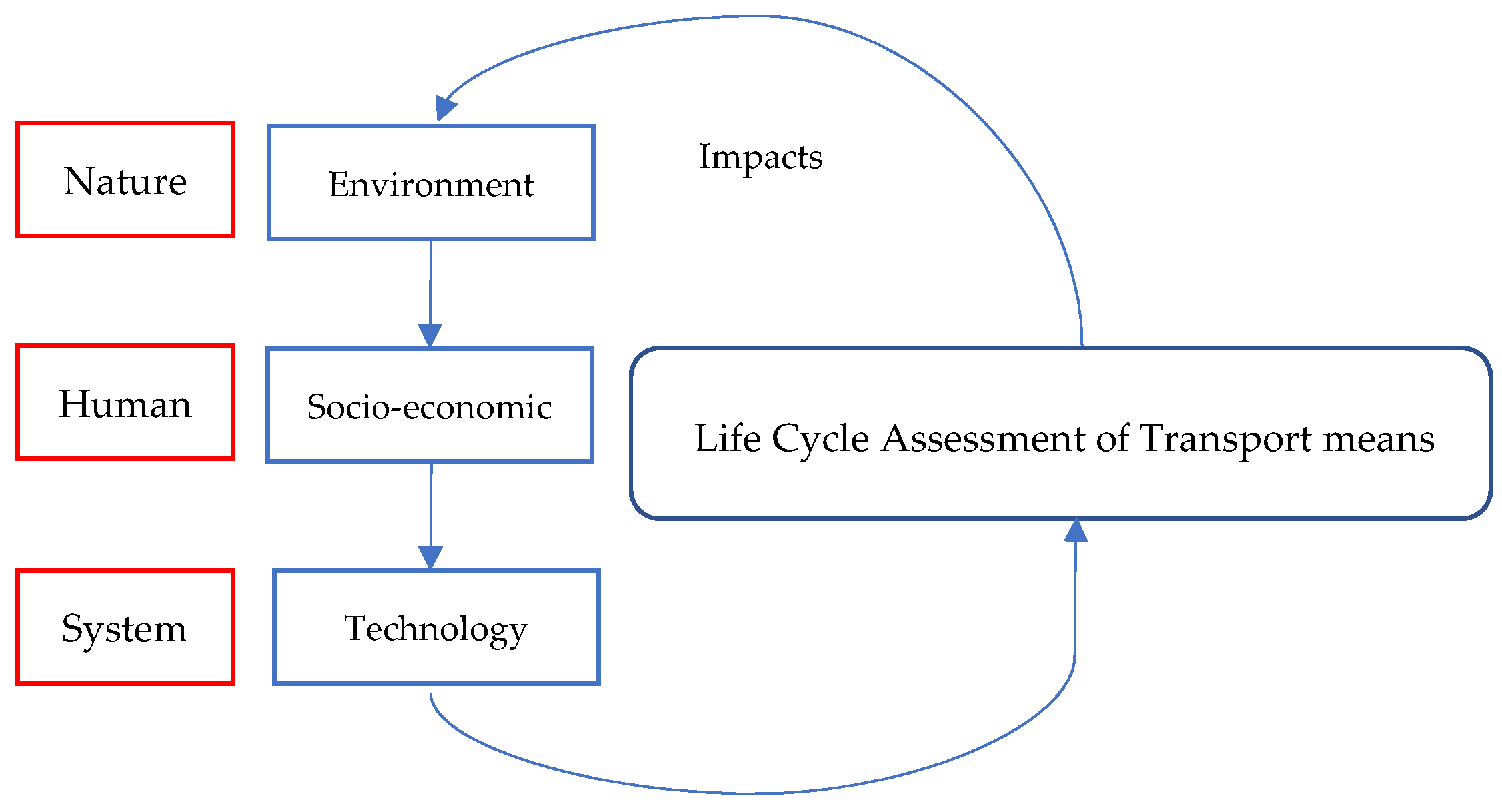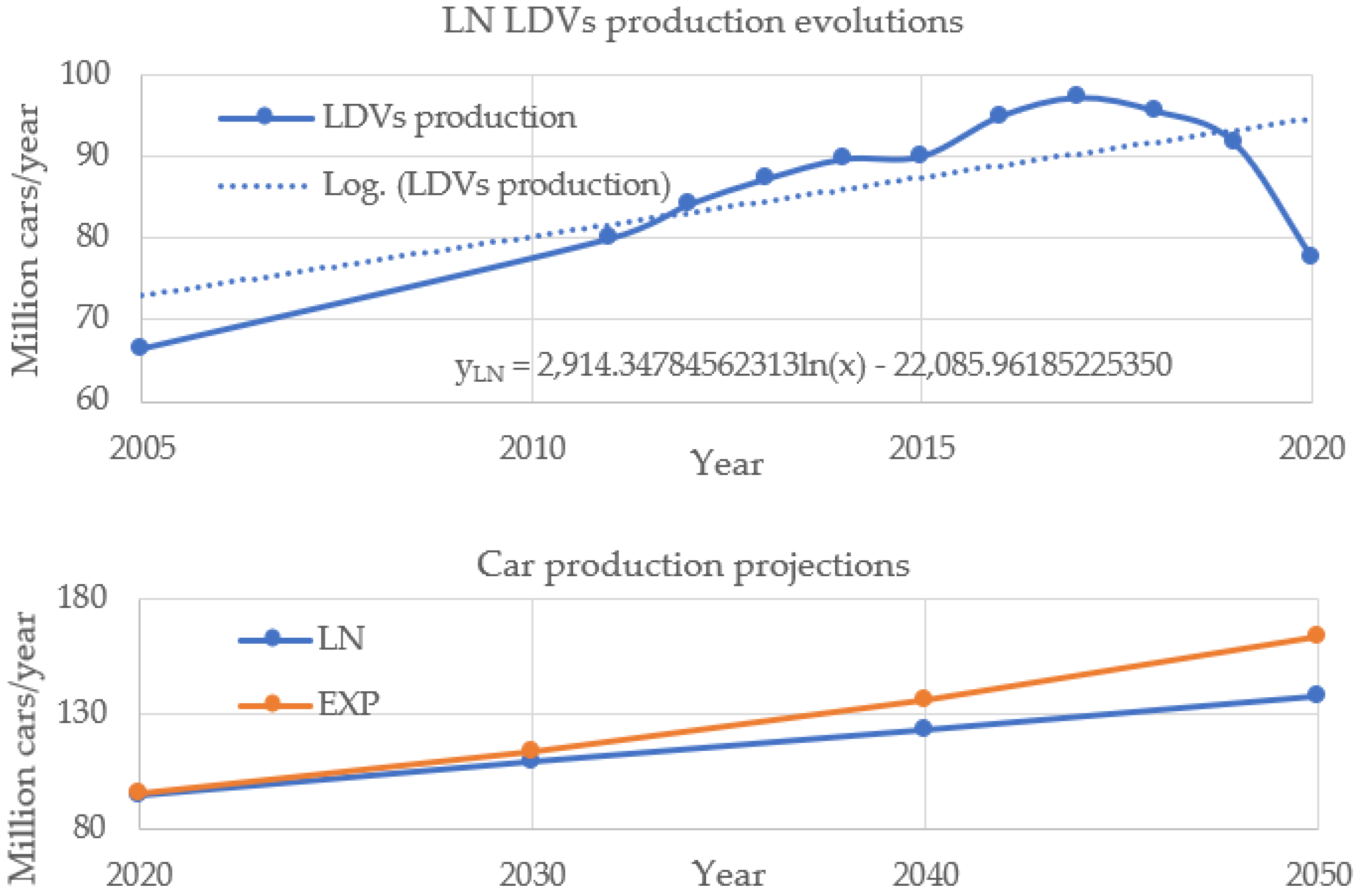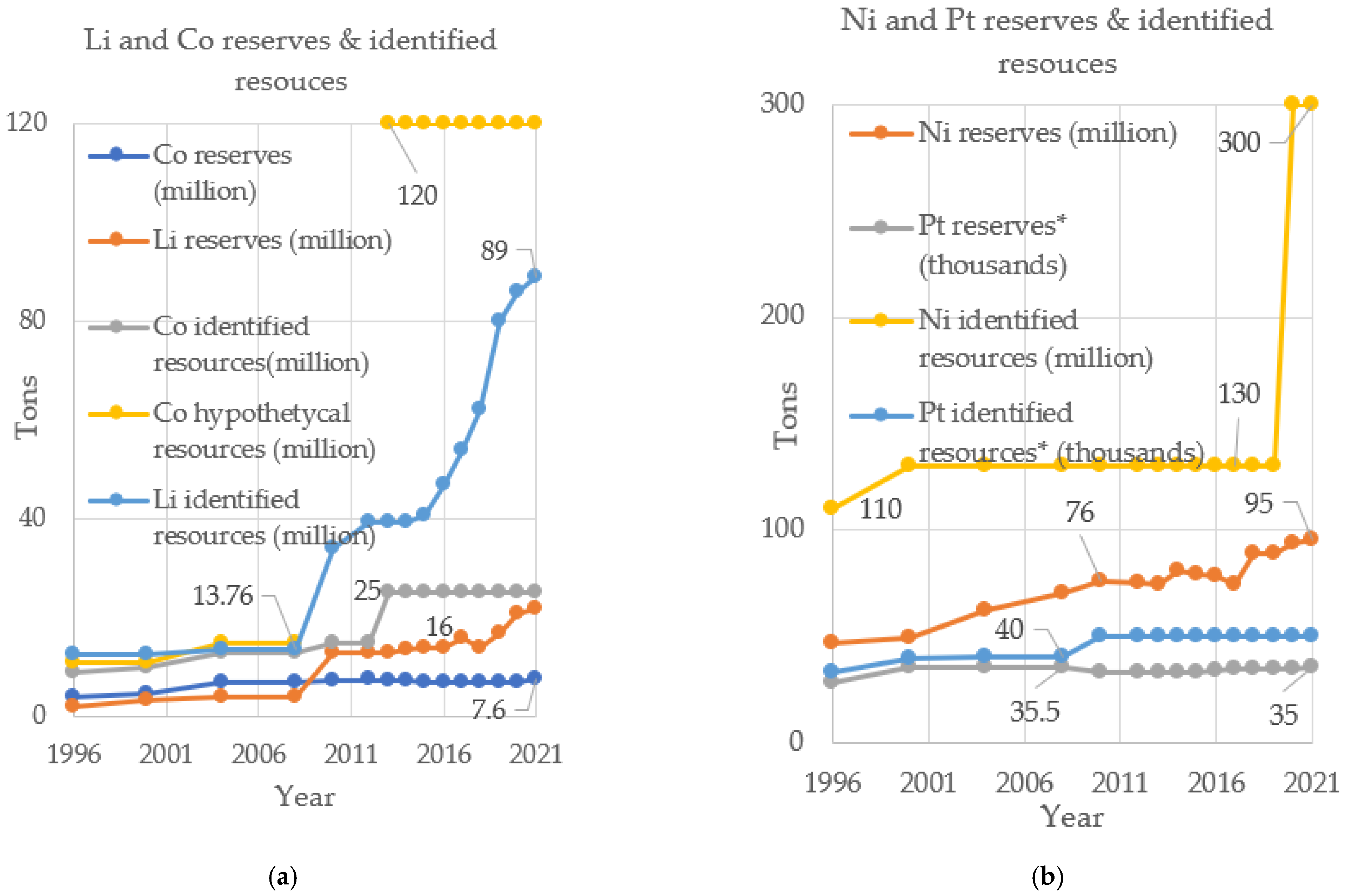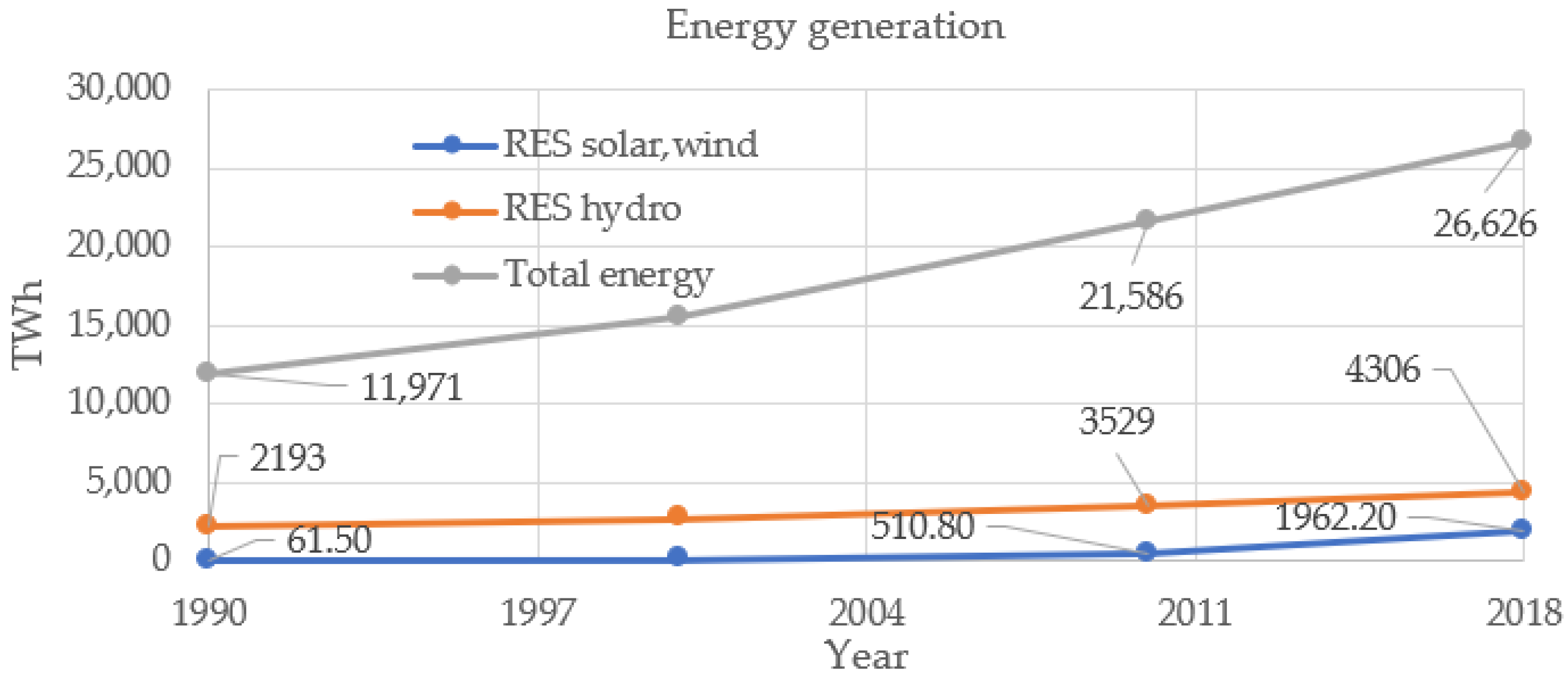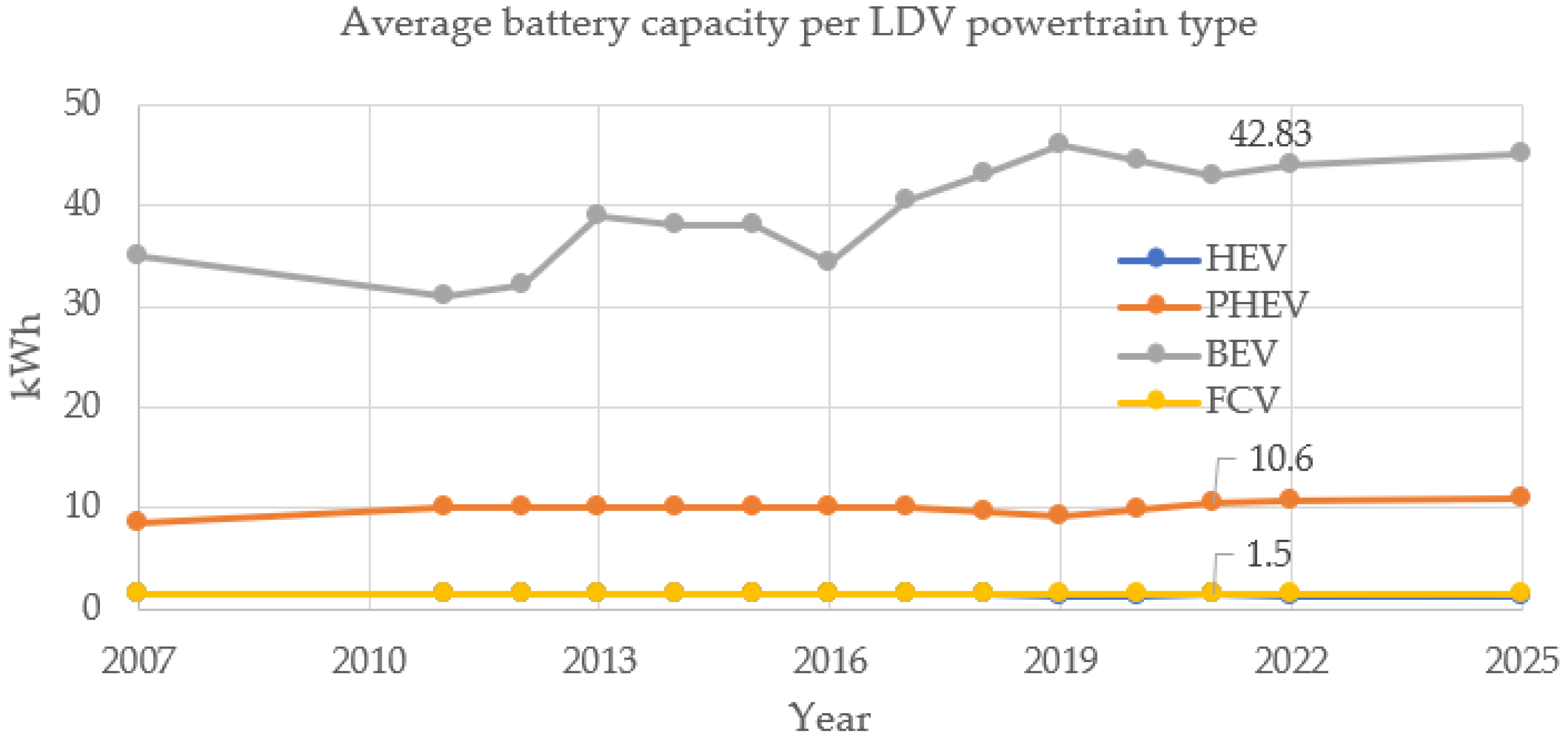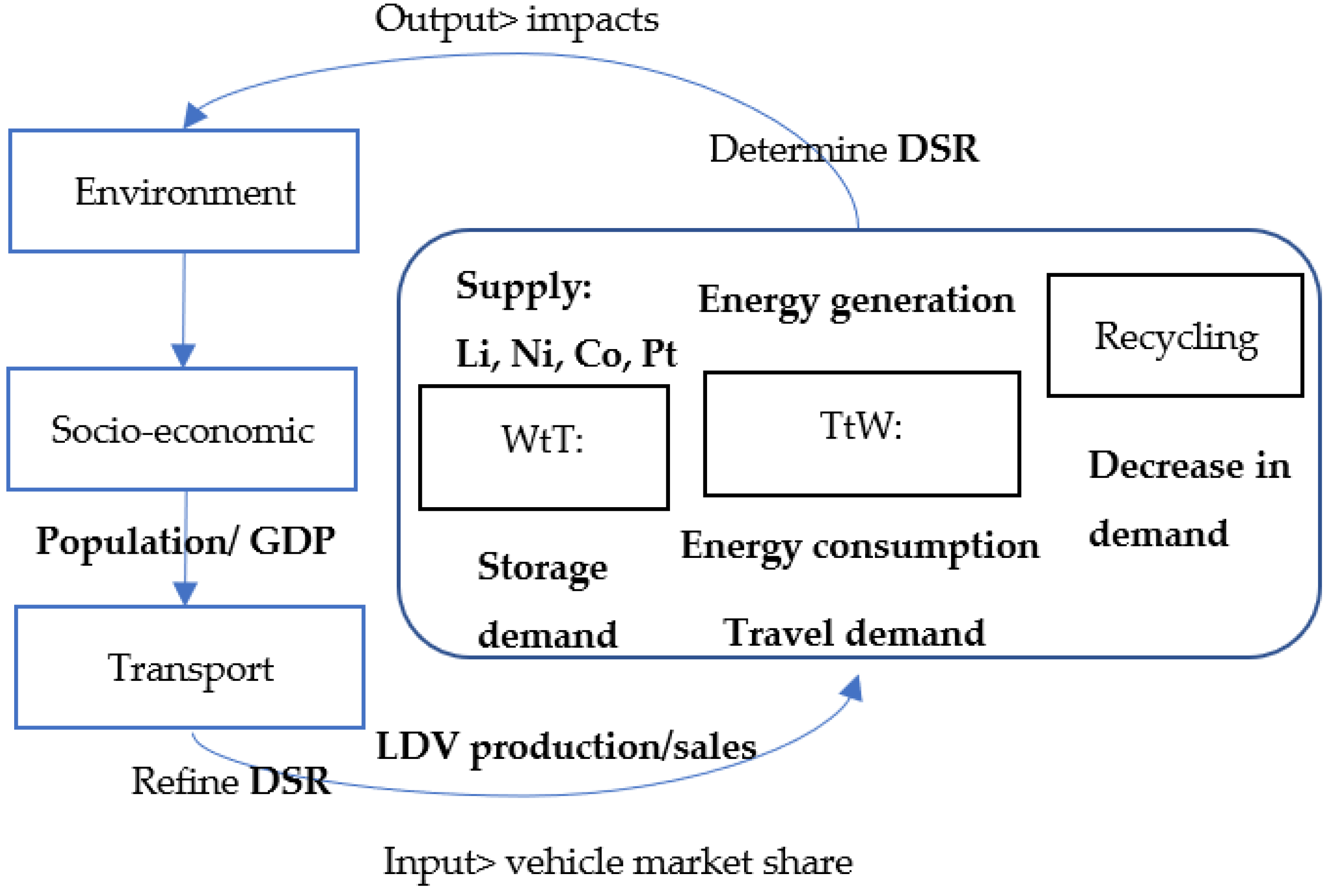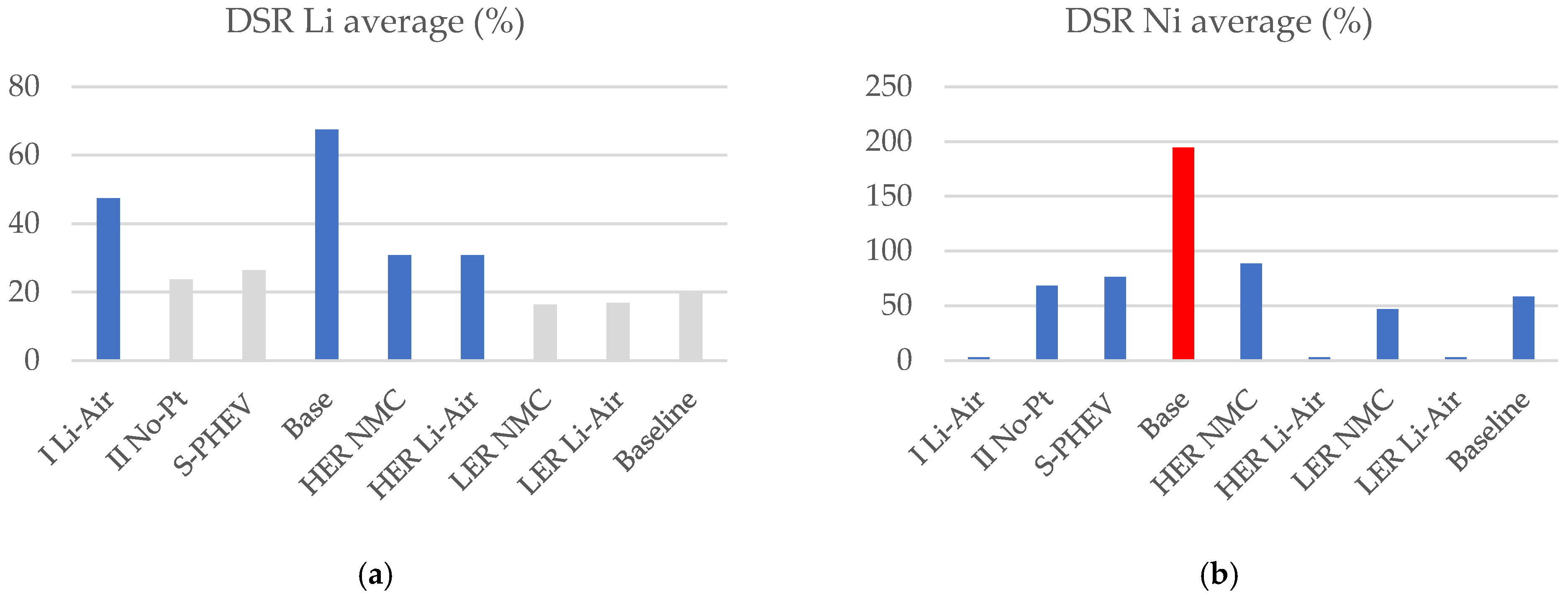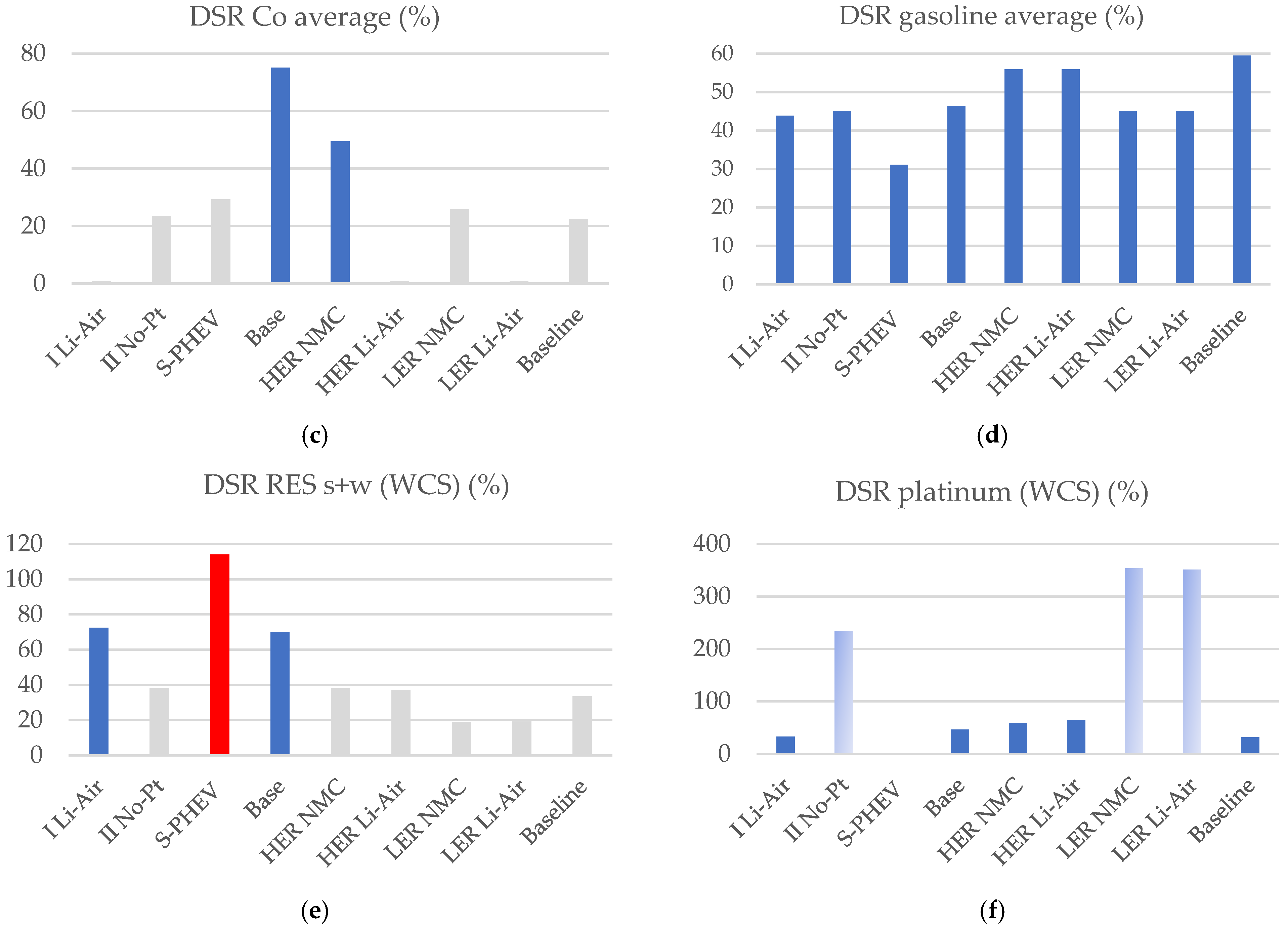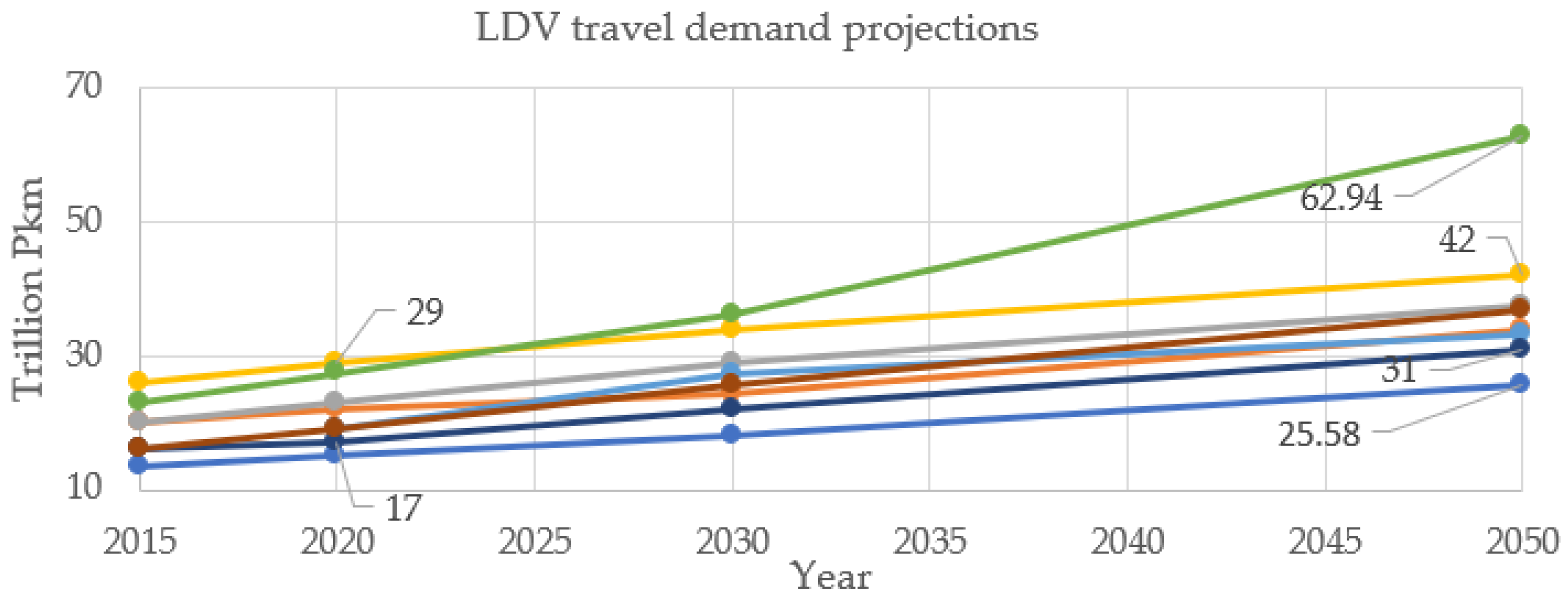Figure 1.
Simplified sustainable transport framework based on the methodology proposed.
Figure 1.
Simplified sustainable transport framework based on the methodology proposed.
Figure 2.
Evolution of: (a) population and GDP from 2000 to 2020; (b) LDVs’ production and sales from 2005 to 2020.
Figure 2.
Evolution of: (a) population and GDP from 2000 to 2020; (b) LDVs’ production and sales from 2005 to 2020.
Figure 3.
Nonlinear evolution and prediction scenarios (LN and EXP) for LDVs’ production including formulas where x = year and y = annual car production.
Figure 3.
Nonlinear evolution and prediction scenarios (LN and EXP) for LDVs’ production including formulas where x = year and y = annual car production.
Figure 6.
Evolution of the identified resources and reserves by USGS for: (
a) lithium and cobalt; (
b) nickel and platinum from 1996 to 2021. * Pt reserves and resources represent 50% of the total Platinum-group metals (PGM) reserves and resources in [
51].
Figure 6.
Evolution of the identified resources and reserves by USGS for: (
a) lithium and cobalt; (
b) nickel and platinum from 1996 to 2021. * Pt reserves and resources represent 50% of the total Platinum-group metals (PGM) reserves and resources in [
51].
Figure 8.
Evolution of: (a) ail reserves, from 2005 to 2020; (b) oil exploitation, from 1990 to 2020.
Figure 8.
Evolution of: (a) ail reserves, from 2005 to 2020; (b) oil exploitation, from 1990 to 2020.
Figure 9.
Energy generation from 1990 to 2018.
Figure 9.
Energy generation from 1990 to 2018.
Figure 10.
Estimated and predicted evolution of the battery capacity of storage-based LDVs from 2007 to 2025.
Figure 10.
Estimated and predicted evolution of the battery capacity of storage-based LDVs from 2007 to 2025.
Figure 11.
Proposed methodology.
Figure 11.
Proposed methodology.
Figure 12.
DSR determinations for (a) lithium-based storage (average), from 2020 to 2050; (b) nickel-based storage (average), from 2005 to 2020; (c) cobalt-based storage (average), from 2020 to 2050; (d) gasoline resources (average), from 2020 to 2050; (e) RES solar and wind resources (WCS), in 2050; (f) platinum resources (WCS), from 2005 to 2020, according to nine scenarios.
Figure 12.
DSR determinations for (a) lithium-based storage (average), from 2020 to 2050; (b) nickel-based storage (average), from 2005 to 2020; (c) cobalt-based storage (average), from 2020 to 2050; (d) gasoline resources (average), from 2020 to 2050; (e) RES solar and wind resources (WCS), in 2050; (f) platinum resources (WCS), from 2005 to 2020, according to nine scenarios.
Figure 13.
Estimated impacts on: (a) GWP; (b) PAC, from 2020 to 2050, according to nine scenarios.
Figure 13.
Estimated impacts on: (a) GWP; (b) PAC, from 2020 to 2050, according to nine scenarios.
Figure 14.
Estimated demand in Billion LGE required for fueling ICEVs and HEVs from 2020 to 2050, according to nine scenarios.
Figure 14.
Estimated demand in Billion LGE required for fueling ICEVs and HEVs from 2020 to 2050, according to nine scenarios.
Figure 15.
Estimated demand in TWh required for charging PHEVs (electric) and BEVs from 2020 to 2050, according to nine scenarios.
Figure 15.
Estimated demand in TWh required for charging PHEVs (electric) and BEVs from 2020 to 2050, according to nine scenarios.
Figure 16.
Estimated demand in Billion Liters of Hydrogen required for fueling FEVs from 2020 to 2050, according to nine scenarios.
Figure 16.
Estimated demand in Billion Liters of Hydrogen required for fueling FEVs from 2020 to 2050, according to nine scenarios.
Table 1.
Comparison between mentioned models and frameworks in terms of data provided based on sustainable transport considerations.
Table 1.
Comparison between mentioned models and frameworks in terms of data provided based on sustainable transport considerations.
| Link | Energy for LDVs | Raw Materials for LDVs | LDV Storage | Vehicle Market Share |
|---|
| Gen./Cons. | Fuels/RES | Supply | Demand | Battery Type and Cap. | LDV Powertrain | Period |
|---|
| [12] | Yes/no | Yes/yes | No | No | No | BEV, PHEV 1 | 2010–2015 |
| [14] | Yes/yes | Yes/yes | Yes | Yes | Yes | All types | 2020–2050 |
| [16] | Yes/yes | Yes/yes | No | No | No | None | - |
| [17] | Yes/yes | Yes/no | No | No | No | None | - |
| [18] | No/yes | Yes/no | No | No | No | BEV, PHEV 1 | 2017–2030 |
| [19] | Yes/yes | Yes 2/yes | No | No | No | None | - |
| [20] | Yes/yes | Yes/no | No | No | No | ICEV, HEV | - |
| [21] | No/no | Yes/no | No | No | No | All types | - |
| [22] | No/no | Yes/no | No | No | No | All types | 2010–2030 |
| [23] | Yes/yes | Yes/no | No | No | No | All types | 2010–2050 |
| [24] | Yes/yes | Yes 2/yes | No | Yes | No | All types | 2020–2100 |
| [25] | No/yes | Yes 2/no | No | No | No | All except HEV | 2015–2050 |
| [26] | Yes/yes | Yes/yes | No | No | No | All except FCV | - |
| [27] | No/yes | Yes 2/no | No | No | No | All types | 2010–2050 |
Table 2.
Values in million cars/year based on the evolution scenarios for LDVs production.
Table 2.
Values in million cars/year based on the evolution scenarios for LDVs production.
| Year | Linear | LN | EXP |
|---|
| 2030 | 109.1791 | 109.1025 | 114.0415 |
| 2040 | 123.6438 | 123.4236 | 136.5359 |
| 2050 | 138.1086 | 137.6747 | 163.4674 |
Table 3.
Approximated degree of correlation (%) between Population and GDP predictions and LN and EXP predictions for the LDVs’ production from 2020 to 2050 (2020, 2030, 2040, 2050).
Table 3.
Approximated degree of correlation (%) between Population and GDP predictions and LN and EXP predictions for the LDVs’ production from 2020 to 2050 (2020, 2030, 2040, 2050).
| Population Predictions Versus LN/EXP LDV Production Predictions |
| [35] 1 | [35] 2 | [36] | [35] 3, [37] | [38] | [39] | [40] 1 | [41] | [42] 1 | [42] 1 | [40] 2 |
| 100/100 | 86/82 | −100/−99 | 100/99 | 100/100 | 100/99 | 100/99 | 100/99 | 96/94 | 99/98 | 100/99 |
| GDP predictions versus LN/EXP LDV production predictions |
| [36] | [43] | [44] 3 | [44] 1 | [37] | [45] | [46] | [47] | [48] | [49] | |
| −63/−69 | 100/100 | 99/100 | 100/100 | 99/99 | 100/100 | 100/100 | 99/100 | 98/99 | 100/100 | |
Table 4.
LDV batteries’ Li, Co, Ni, and Pt demand per vehicle.
Table 4.
LDV batteries’ Li, Co, Ni, and Pt demand per vehicle.
| Battery Type | Lithium (kg/kWh) | Cobalt (kg/kWh) | Nickel (kg/kWh) | Platinum (kg) |
|---|
| For FCV | 0.046 |
| For BEV/PHEV/HEV |
| NMC/NCM | 0.133 | 0.32 | 0.435 | - |
| NCA | 0.242 | 0.142 | 0.79 | - |
| LFP | 0.168 | - | 0.01 | - |
| Li-S | 0.412 | - | - | - |
| Li-Air | 0.136 | - | - | - |
Table 5.
Approximated overall degree of correlation (%) between population, GDP, car production and sales predictions, and predictions for the LDVs’ travel demand from 2015 to 2050 (2015, 2020, 2030, 2050).
Table 5.
Approximated overall degree of correlation (%) between population, GDP, car production and sales predictions, and predictions for the LDVs’ travel demand from 2015 to 2050 (2015, 2020, 2030, 2050).
| LN/EXP LDV Production and Sales (Including GDP, Population) Predictions Versus LDV Travel Demand Predictions |
| [52] | [53] | [54,55] | [56] | [57] | [58] | [59] | [60] |
| 100/100 | 99/99 | 100/99 | 100/99 | 96/94 | 99/100 | 100/100 | 100/100 |
Table 6.
Worst-case scenario (WCS) and best-case scenario (BCS) predictions for solar and wind RESs’ generation in TWh.
Table 6.
Worst-case scenario (WCS) and best-case scenario (BCS) predictions for solar and wind RESs’ generation in TWh.
| Year | WCS | BCS |
|---|
| 2020 | 2500 | 3500 |
| 2030 | 8000 | 16,000 |
| 2050 | 16,500 | 40,000 |
Table 7.
Projected decrease in demand for materials (%) from 2020 to 2050.
Table 7.
Projected decrease in demand for materials (%) from 2020 to 2050.
| Year | Li | Ni | Co | Pt |
|---|
| 2020 | 0.15% | 0.13% | 0.25% | 0.01% |
| 2030 | 6% | 5% | 8% | 6% |
| 2040 | 20% | 22% | 30% | 20% |
| 2050 | 30% | 32% | 42% | 50% |
Table 8.
Estimated and projected rate of adoption per battery chemistry in EVs (%), assuming no Li-S or Li-Air market penetration for the 2020–2030 period.
Table 8.
Estimated and projected rate of adoption per battery chemistry in EVs (%), assuming no Li-S or Li-Air market penetration for the 2020–2030 period.
| Year | NMC | LFP | NCA |
|---|
| 2018 [83] | 45% | 15% | 39% |
| 2019 [83] | 53% | 3% | 43% |
| 2020 [83] | 58% | 0% | 42% |
| 2025 [83] | 64% | 0% | 36% |
| 2030 [14] | 72% | 0% | 28% |
Table 9.
Battery capacity per vehicle (kWh) estimations and predictions for the 2020–2050 period.
Table 9.
Battery capacity per vehicle (kWh) estimations and predictions for the 2020–2050 period.
| Scenario and Year | HEV | PHEV | BEV | FCV |
|---|
| BAU-LN 2020 | 1.4 | 10 | 44.4 | 1.5 |
| BAU 2030 | 1.5 | 11 | 46 | 1.5 |
| BAU 2050 | 1.5 | 12 | 50 | 1.5 |
| LN 2030 | 1.7 | 11.2 | 51 | 1.7 |
| LN 2050 | 2 | 13 | 67.6 | 2 |
Table 10.
Vehicle market share (%) estimations and predictions for the 2020–2050 period.
Table 10.
Vehicle market share (%) estimations and predictions for the 2020–2050 period.
| Scenario and Year | ICEV | HEV | PHEV | BEV | FCV |
|---|
| BAU [23] 2020 | 91.6 | 7.2 | 1.164 | 0.001 | 0 |
| BAU [23] 2030 | 87.6 | 9.5 | 2.924 | 0.001 | 0 |
| BAU [23] 2050 | 84 | 10.8 | 5.217 | 0.001 | 0 |
| S-HEV [23] 2020 | 80.3 | 19.2 | 0.501 | 0.001 | 0 |
| S-HEV [23] 2030 | 53.5 | 46.1 | 0.334 | 0.001 | 0 |
| S-HEV [23] 2050 | 0 | 100 | 0 | 0 | 0 |
| S-PHEV [23] 2020 | 80.3 | 4.9 | 14.786 | 0 | 0 |
| S-PHEV [23] 2030 | 53.5 | 3.3 | 43.191 | 0 | 0 |
| S-PHEV [23] 2050 | 0 | 0 | 100 | 0 | 0 |
| S-EV [23] 2020 | 80.3 | 4.9 | 0.501 | 14.287 | 0 |
| S-EV [23] 2030 | 53.5 | 3.3 | 0.334 | 42.458 | 0 |
| S-EV [23] 2050 | 0 | 0 | 0 | 100 | 0 |
| Base [25] 2020 | 82.7 | 12 | 1.2 | 4 | 0.1 |
| Base [25] 2030 | 33.9 | 55 | 3 | 8 | 0.1 |
| Base [25] 2050 | 0.5 | 10 | 20 | 59.5 | 10 |
| Alt. 1 [25] 2020 | 82.7 | 12 | 1.2 | 4 | 0.1 |
| Alt. 1 [25] 2030 | 17.9 | 47 | 15 | 20 | 0.1 |
| Alt. 1 [25] 2050 | 0 | 0 | 0 | 100 | 0 |
| Alt. 2 [25] 2020 | 82.7 | 12 | 1.2 | 4 | 0.1 |
| Alt. 2 [25] 2030 | 16 | 47 | 15 | 20 | 2 |
| Alt. 2 [25] 2050 | 0 | 0 | 15 | 20 | 65 |
| Scenario [27] 2020 | 88.5 | 6.5 | 3 | 2 | 0 |
| Scenario [27] 2030 | 68 | 18.5 | 7.5 | 5 | 1 |
| Scenario [27] 2050 | 45.5 | 19.5 | 18 | 11 | 6 |
| HER av. NMC [14] 2020 | 76.613 | 19.153 | 0.954 | 3.18 | 0.1 |
| HER av. NMC [14] 2030 | 56 | 24 | 1.76 | 5.865 | 12.375 |
| HER av. NMC [14] 2050 | 29.7 | 29.7 | 9.362 | 31.207 | 0.031 |
| HER av. Li-Air [14] 2020 | 76.685 | 19.172 | 0.933 | 3.11 | 0.1 |
| HER av. Li-Air [14] 2030 | 56 | 24 | 1.721 | 5.735 | 12.544 |
| HER av. Li-Air [14] 2050 | 29.7 | 29.7 | 9.156 | 30.519 | 0.925 |
| LER av. NMC [14] 2020 | 76.613 | 19.153 | 0.954 | 3.18 | 0.1 |
| LER av. NMC [14] 2030 | 49 | 21 | 1.496 | 4.985 | 23.519 |
| LER av. NMC [14] 2050 | 15.565 | 15.565 | 3.671 | 12.237 | 52.962 |
| LER av. Li-Air [14] 2020 | 76.685 | 19.172 | 0.933 | 3.11 | 0.1 |
| LER av. Li-Air [14] 2030 | 49 | 21 | 1.463 | 4.875 | 23.662 |
| LER av. Li-Air [14] 2050 | 15.565 | 15.565 | 3.81 | 12.7 | 52.36 |
Table 11.
Demand in raw materials (in kg Ni, Li, Co, and g Pt per vehicle) for the BAU and LN battery capacity scenarios based on battery chemistry in 2020, 2030, and 2050.
Table 11.
Demand in raw materials (in kg Ni, Li, Co, and g Pt per vehicle) for the BAU and LN battery capacity scenarios based on battery chemistry in 2020, 2030, and 2050.
| Scenario and Year | Battery Chemistries | Raw Materials | HEV | PHEV | BEV | FCV |
|---|
| BAU-LN 2020 | 58% NMC—42% NCA | Ni | 0.81774 | 5.841 | 25.93404 | 0.87615 |
| BAU 2030 | 72% NMC—28% NCA | 0.8016 | 5.8784 | 24.5824 | 0.8016 |
| 100% NMC | 0.6525 | 4.785 | 20.01 | 0.6525 |
| 100% Li-Air | 0 | 0 | 0 | 0 |
| BAU 2050 | 72% NMC—28% NCA | 0.8016 | 6.4128 | 26.72 | 0.8016 |
| 100% NMC | 0.6525 | 5.22 | 21.75 | 0.6525 |
| 100% Li-Air | 0 | 0 | 0 | 0 |
| LN 2030 | 72% NMC—28% NCA | 0.90848 | 5.98528 | 27.2544 | 0.90848 |
| 100% NMC | 0.7395 | 4.872 | 22.185 | 0.7395 |
| 100% Li-Air | 0 | 0 | 0 | 0 |
| LN 2050 | 72% NMC—28% NCA | 1.0688 | 6.9472 | 36.12544 | 1.0688 |
| 100% NMC | 0.87 | 5.655 | 29.406 | 0.87 |
| 100% Li-Air | 0 | 0 | 0 | 0 |
| BAU-LN 2020 | 58% NMC—42% NCA | Li | 0.250292 | 1.7878 | 7.937832 | 0.26817 |
| BAU 2030 | 72% NMC—28% NCA | 0.24528 | 1.79872 | 7.52192 | 0.24528 |
| 100% NMC | 0.1995 | 1.463 | 6.118 | 0.1995 |
| 100% Li-Air | 0.204 | 1.496 | 6.256 | 0.204 |
| BAU 2050 | 72% NMC—28% NCA | 0.24528 | 1.96224 | 8.176 | 0.24528 |
| 100% NMC | 0.1995 | 1.596 | 6.65 | 0.1995 |
| 100% Li-Air | 0.204 | 1.632 | 6.8 | 0.204 |
| LN 2030 | 72% NMC—28% NCA | 0.277984 | 1.831424 | 8.33952 | 0.277984 |
| 100% NMC | 0.2261 | 1.4896 | 6.783 | 0.2261 |
| 100% Li-Air | 0.2312 | 1.5232 | 6.936 | 0.2312 |
| LN 2050 | 72% NMC—28% NCA | 0.32704 | 2.12576 | 11.05395 | 0.32704 |
| 100% NMC | 0.266 | 1.729 | 8.9908 | 0.266 |
| 100% Li-Air | 0.272 | 1.768 | 9.1936 | 0.272 |
| BAU-LN 2020 | 58% NMC—42% NCA | Co | 0.343336 | 2.4524 | 10.88866 | 0.36786 |
| BAU 2030 | 72% NMC—28% NCA | 0.40524 | 2.97176 | 12.42736 | 0.40524 |
| 100% NMC | 0.48 | 3.52 | 14.72 | 0.48 |
| 100% Li-Air | 0 | 0 | 0 | 0 |
| BAU 2050 | 72% NMC—28% NCA | 0.40524 | 3.24192 | 13.508 | 0.40524 |
| 100% NMC | 0.48 | 3.84 | 16 | 0.48 |
| 100% Li-Air | 0 | 0 | 0 | 0 |
| LN 2030 | 72% NMC—28% NCA | 0.459272 | 3.025792 | 13.77816 | 0.459272 |
| 100% NMC | 0.544 | 3.584 | 16.32 | 0.544 |
| 100% Li-Air | 0 | 0 | 0 | 0 |
| LN 2050 | 72% NMC—28% NCA | 0.54032 | 3.51208 | 18.26282 | 0.54032 |
| 100% NMC | 0.64 | 4.16 | 21.632 | 0.64 |
| 100% Li-Air | 0 | 0 | 0 | 0 |
| BAU-LN 2020–2050 | - | Pt | 0 | 0 | 0 | 46 |
Table 12.
Estimated demand in gasoline (billion LGE) in 2020, 2030, and 2050 and in RES energy (TWh) in 2050.
Table 12.
Estimated demand in gasoline (billion LGE) in 2020, 2030, and 2050 and in RES energy (TWh) in 2050.
| Demand | Year | WCS (High) | BCS (Low) |
|---|
| Gasoline | 2020 | 1923.74 | 1190 |
| 2030 | 2168.7 | 1320 |
| 2050 | 2517.68 | 1240 |
| RES energy | 2050 | 9834.688 | 4843.75 |
Table 13.
Supply (resources) for LDVs’ storage and energy (fuel/electricity) available by 2050.
Table 13.
Supply (resources) for LDVs’ storage and energy (fuel/electricity) available by 2050.
| Supply | Unit | Type | WCS (Low) | BCS (High) |
|---|
| Storage for EVs | Million tons | Ni | 13.49 | 42.6 |
| Li | 11.44 | 46.28 |
| Co | 16.5 | 79.2 |
| Resources for FCV | Kilotons | Pt | 16.5 | 23.5 |
| Energy for ICEV/HEV | Billion LGE | Gasoline | 73,440 |
| Energy for PHEV/BEV | TWh | RES solar + wind | 16,500 | 40,000 |
Table 14.
DSR (%) determinations for the current scenarios for the 2020–2050 period.
Table 14.
DSR (%) determinations for the current scenarios for the 2020–2050 period.
| Scenario | Nickel WCS/BCS | Lithium WCS/BCS | Cobalt WCS/BCS | Platinum WCS/BCS | Gasoline WCS/BCS | RES Solar Wind WCS |
|---|
| BAU [23] | 9.6/2.5 | 3.5/0.7 | 4/0.7 | 0/0 | 91/52 | 6.65 |
| S-HEV [23] | 19.3/4.3 | 7/1.2 | 8/1.2 | 0/0 | 94/53.4 | 0.5 |
| S-PHEV [23] | 121/31.8 | 43.7/9 | 50/8.6 | 0/0 | 38.6/23.6 | 114 |
| S-EV [23] | 601/132 | 217/37 | 247/36 | 0/0 | 38.6/23.6 | 113.7 |
| Base [25] | 321/67.6 | 116/19 | 132/18.3 | 46.2/27.4 | 58/35 | 70 |
| Alt. 1 [25] | 529/112 | 191/31.5 | 218/30.3 | 0.64/0.43 | 43.6/26.7 | 103 |
| Alt. 2 [25] | 200/48 | 72/13.4 | 82.2/12.8 | 306/182 | 43.6/26.7 | 54.7 |
| Scenario [27] | 95/21.9 | 34.3/6.2 | 39/5.9 | 32.1/19.4 | 75.5/43.5 | 33.4 |
| HER NMC [14] | 146/31.3 | 52.7/8.8 | 86.8/12.1 | 59.3/39.8 | 70.9/41 | 38 |
| HER Li-Air [14] | 4.3/1.4 | 52.7/8.8 | 1.5/0.3 | 64.2/42.8 | 70.9/41 | 37.1 |
| LER NMC [14] | 76.9/17.3 | 27.7/4.9 | 45/6.6 | 354/218 | 56.7/33.4 | 18.7 |
| LER Li-Air [14] | 4.3/1.4 | 28.8/5 | 1.5/0.3 | 352/217 | 56.7/33.4 | 19 |
Table 15.
Vehicle market share (%) for the two novel scenarios for the 2020–2050 period.
Table 15.
Vehicle market share (%) for the two novel scenarios for the 2020–2050 period.
| Scenario and Year | ICEV | HEV | PHEV | BEV | FCV |
|---|
| I Li-Air 2020 | 76.6 | 19.1 | 1 | 3.2 | 0.1 |
| I Li-Air 2030 | 44.5 | 20.1 | 13.5 | 18.5 | 3.4 |
| I Li-Air 2050 | 13.5 | 20.3 | 25.4 | 37 | 3.8 |
| II NMC-NCA 2020 | 76.6 | 19.1 | 1 | 3.2 | 0.1 |
| II NMC-NCA 2030 | 49 | 21 | 9 | 5 | 16 |
| II NMC-NCA 2050 | 15.6 | 15.6 | 22 | 12.2 | 34.6 |
Table 16.
DSR (%) determinations for the two novel scenarios for the 2020–2050 period.
Table 16.
DSR (%) determinations for the two novel scenarios for the 2020–2050 period.
| Scenario | Nickel WCS/BCS | Lithium WCS/BCS | Cobalt WCS/BCS | Platinum WCS/BCS | Gasoline WCS/BCS | RES Solar Wind WCS |
|---|
| I Li-Air | 4.43/1.4 | 80.6/14.2 | 1.52/0.3 | 33.7/21.2 | 55.2/32.4 | 72.4 |
| II NMC-NCA | 111.2/25.7 | 40.2/7.2 | 40.1/7 | ~0/~0 * | 56.7/33.4 | 38 |
Table 17.
Global Warming Potential (GWP) expressed in kgCO2 e/km, Pollution Abatement Costs (PAC) in EUR/km, and Gasoline, Electricity, and Hydrogen (GEH) consumption in LGE/km, kWh/km, and, respectively, Liter of Hydrogen/km for various LDV powertrains, based on estimations, forecast, and assumptions, for the 2020–2050 period.
Table 17.
Global Warming Potential (GWP) expressed in kgCO2 e/km, Pollution Abatement Costs (PAC) in EUR/km, and Gasoline, Electricity, and Hydrogen (GEH) consumption in LGE/km, kWh/km, and, respectively, Liter of Hydrogen/km for various LDV powertrains, based on estimations, forecast, and assumptions, for the 2020–2050 period.
| Impact and Year | ICEV | HEV | PHEV | BEV | BEV Clean * | FCV |
|---|
| GWP 2020 | 0.22 | 0.2 | 0.18 | 0.15 | 0.04 | 0.15 |
| GWP 2030 | 0.19 | 0.18 | 0.16 | 0.13 | 0.03 | 0.14 |
| GWP 2050 | 0.145 | 0.14 | 0.12 | 0.1 | 0.02 | 0.13 |
| PAC 2020–2050 | 0.047 | 0.041 | 0.042 | 0.036 | - | 0.046 |
| GEH 2020 ** | 6.5 | 5.5 | 21 | 17 | - | 7 |
| GEH 2030 ** | 4.23 | 3.7632 | 19 | 16 | - | 6 |
| GEH 2050 ** | 3.0576 | 2.352 | 16 | 12.5 | - | 5 |
Table 18.
Population projections.
Table 18.
Population projections.
| Link–Year | Extrapolation * | Parameters | Values | Uncertainty—Confidence Interval |
|---|
| [35]–2004 | Nonlinear | Fertility, life expectancy | L to H | Mortality—80–95% |
| [36]–2015 | Almost linear | GDP, growth rate | L | Not assessed |
| [37]–2006 | Unknown | Fertility, growth rate, life expectancy | M | Not assessed |
| [38]–2020 | Unknown | Fertility | M-H | Not assessed |
| [39]–2017 | Nonlinear | Fertility, growth rate, life expectancy | M | Not assessed |
| [40]–2019 | Nonlinear | Fertility-mortality, growth rate-ageing, migration | M to H | Fertility, mortality, migration—95% |
| [41]–2017 | Nonlinear | Fertility, growth rate, life expectancy, education | M | Not assessed |
| [42]–2021 | Nonlinear | Fertility, life expectancy | M | Fertility, ageing, stagnation—0–95% |
| This study | Nonlinear | Fertility, life expectancy, growth rate, mortality | M to H | Migration, fertility, ageing—90–95% |
Table 19.
GDP projections.
Table 19.
GDP projections.
| Link–Year | Extrapolation * | Parameters | Values | Uncertainty—Confidence Interval |
|---|
| [36]–2015 | Almost linear | Growth rate, capital, population | L | Population decline—none |
| [37]–2006 | Unknown | Growth rate, production–consumption | L-M | Global public policies—none |
| [43]–2012 | Nonlinear | Growth rate, capital, education, energy–productivity | M | Energy price—none |
| [44]–2015 | Nonlinear | Capital, education, population, energy–productivity | M | Geopolitical context—none |
| [45]–2018 | Unknown | Capital, income, population, and employment data | M | Not assessed |
| [46]–2022 | Unknown | Energy transition | L | Not assessed |
| [47]–2017 | Nonlinear | Investment opportunities | H | Not assessed |
| [48]–2021 | Nonlinear | Growth rate, environment scores | M-H | Not assessed |
| [49]–2021 | Linear | Unknown | M | Unknown |
| This study | Nonlinear | Capital, population, energy–productivity | L to H | Education, energy price—95% |
Table 20.
LDV sales and production projections.
Table 20.
LDV sales and production projections.
| Link–Year | Extrapolation * | Parameters | Values | Uncertainty—Confidence Interval |
|---|
| [14]–2021 | Nonlinear | Population, GDP, travel demand | M to H | Vehicle market share—80–95% |
| [23]–2016 | Nonlinear | Population, income, vehicle market share | L-M | Fuel economy, behavior—none |
| [24]–2019 | Nonlinear | Fuel economy ** | L to M | Not assessed |
| [25]–2018 | Almost linear | Vehicle market share, purchase probability *** | M | Not assessed |
| [27]–2012 | Nonlinear | Population, GDP | H | Not assessed |
| This study | Nonlinear | Population, GDP, energy–materials dependency | L to H | Vehicle market share, prices—95% |
Table 21.
LDV travel demand projections.
Table 21.
LDV travel demand projections.
| Link–Year | Extrapolation * | Parameters | Values | Uncertainty—Confidence Interval |
|---|
| [52]–2017 | Almost linear | GDP, population, travel preferences | L | Economic growth—none |
| [53]–2018 | Unknown | Unknown | M | Not assessed |
| [54]–2017 | Unknown | GDP, population, travel preferences, technology | M | Not assessed |
| [55]–2004 | Linear | Travel preferences | M | Not assessed |
| [56]–2012 | Nonlinear | Growth rate, travel preferences | M-H | Not assessed |
| [57]–2015 | Nonlinear | Growth rate | M | Fuel prices—none |
| [58]–2019 | Almost linear | GDP, population | H | Not assessed |
| [59]–2020 | Almost linear | Unknown | L-M | Not assessed |
| [60]–2018 | Nonlinear | Population, travel preferences | M | Not assessed |
| This study | Nonlinear | GDP, population, growth rate, technology | L to H | Economic growth, prices—90–95% |
Table 22.
Battery capacity data estimations and projections.
Table 22.
Battery capacity data estimations and projections.
| Link–Year | Study Interval | Vehicle Type (Except ICEV) | Estimation (Studies) or Projection (Uncertainty) |
|---|
| [69]–2021 | 2012–2019 | BEV | Est.: Based on real data/literature (many studies) |
| [70]–2022 | 2011–2021 | Almost all * | Est.: Based on real data/literature (many studies) |
| [71]–2020 | 2019 | BEV, PHEV, HEV | Est.: Only one study case |
| [72]–2021 | 2021 | BEV, HEV | Est.: Only one study case |
| [73]–2018 | 2013 | BEV, PHEV, HEV | Est.: Only one study case |
| [74]–2007 | 2007 | BEV, PHEV, HEV | Est.: Based on real data/literature (many studies) |
| [75]–2011 | 2007 | BEV, PHEV, HEV | Est.: Based on real data/literature (many studies) |
| [76]–2019 | 2019 | PHEV, BEV | Est.: Based on real data/literature (many studies) |
| [77]–2022 | 2013 | BEV, PHEV, HEV | Est.: Based on real data/literature (a few studies) |
| [78]–2018 | 2017–2025 | BEV, PHEV | Pro.: Uncertainty not assessed (based only on 2 years) |
| [79]-2018 | 2015–2016 | HEV | Est.: Only two study cases |
| [80]-2019 | Unknown | BEV, PHEV, HEV | Est.: Based on real data/literature (many studies) |
| [81]-2021 | 2021 | BEV, PHEV, HEV | Est.: only one study case |
| This study | 2007–2050 | Almost all * | Est.: Based on literature, Pro.: 80–95% confidence |
